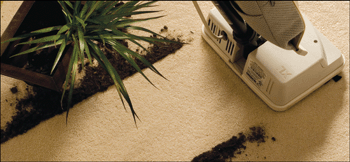Carpet maintenance and cleaning allocated by mills - Call for continued warranty education, permeation
It’s been almost a year-and-a-half now since leading carpet mills such as Shaw, Mohawk and Beaulieu in conjunction with the Carpet & Rug Institute (CRI) added maintenance and cleaning specifications to many of their products’ warranties in an effort to show consumers broadloom can and should be cleaned and properly maintained to prolong its beauty and life.
Then, at the start of this year the Institute of Inspection, Cleaning and Restoration Certification (IICRC) jumped on board cleaning up carpets’ bad wrap by working with the mills to add requirements as to who should clean consumer carpets— only IICRC certified cleaners.
According to several studies done by CRI, the average consumer’s impression of carpet dropped significantly in the early 2000s. Organizations such as the CRI and IICRC, and manufacturers alike, said this was largely due to improper removal of old carpet, untrained installers and cleaners, leaky vacuums and insufficient chemical cleaning products. In fact, CRI found in a study done on chemical cleaning agents nearly 80% of the products on the market were as effective as water, and many heightened re-soiling.
To combat these issues, CRI developed its Green Label vacuum program, which forced the vacuum industry to look at, reevaluate and improve its products. The organization also came out with a cleaning solution testing initiative under its Seal of Approval program, which again refocused the cleaning companies to put out enhanced formulations. And most recently, as stated above, the group joined forces with mills and IICRC to promote effective carpet cleaning and maintenance done by certified professionals.
“Consumers should be interested in this information,” said Pat Jennings, communications specialist for CRI. “They have invested a lot of money into their floor, and this is knowledge that they need.”
Jeff Bishop, technical advisor for the IICRC, agreed, comparing this movement to what happened years ago in the auto industry. “It started off slow, but now people know that in order to maintain the validity of their car’s warranty, they have to get regular maintenance measured by mileage, or change their oil every 3,000 miles. We need to educate people—mills, retailers, installers, consumers, etc.—to that same level on how to properly maintain carpet so that it can provide a decent service life to the end user. Adding specifications to the products warranties is one way to do that.” He noted, aside from that, carpet’s name needs to be cleared. “Manufacturers and retailers alike are losing billions of dollars in claims costs.”
However, even with the immense progress over the past decade, there has been a disconnect somewhere. When speaking with retailers, FCNews found more than not were unaware that any of these maintenance guidelines had been added to carpet warranties.
And, those that were aware said the requirements definitely had not permeated the industry yet. Chris Davis, president and CEO of the World Floor Covering Association (WFCA), the largest retail advocacy group in the industry, said when these implementations were first proposed, the association took a very supportive stance provided the mills do their part to communicate the information on both the retail and consumer levels.
In fact, WFCA sent its members an announcement— with CRI’s blessing— a year-and-a-half ago laying out the warranty changes for each mill on each product. Davis said it was disconcerting when floods of confused retailers started calling. “I would get phone calls from members who had called their mill reps to discuss the warranty additions and the reps didn’t have a clue what the dealers were talking about.”
He noted in order to permeate down to the end user, manufacturers have to start by educating their own sales force.
Gary Cissel, flooring director of Nebraska Furniture Mart, was one of the few dealers aware of the warranty inclusions. But, he said it’s still pretty early in the game to see a significant impact. “There’s definitely still a lack of consumer maintenance and a lack of knowledge. However, we find that our customers have been very receptive to the information and interested in the findings.”
He agreed with Davis saying it has to be a group effort starting at the top, which will take a few years. “The mills need to educate their retail partners who then need to educate the customer. I don’t think these will be hard-fast rules of the carpet segment for some time still, but we’re heading in the right direction.”
 |
Related News
Saturday, July 12, 2025
By Emily Hooper Though the resilient category isn’t in the clear just yet, conditions are improving— as much as the flooring industry can improve in this economy. In this case, improving means 2010 may be the end to a consistent drop in category sales since 2006...read more
Over the last nine months, the flooring operations at Invista have undergone a number of major internal changes, from being separated into its own operating division to having a new president for the business unit that oversees it. Invista’s flooring business, now known as Surfaces, integrates its...read more
PHOENIX—The U.S. Green Building Council (USGBC) has introduced its latest green building rating system, LEED for Healthcare. The rating system guides the design and construction of new buildings and major renovations of existing ones, and can be applied to...read more
DALLAS—Quick•Step flooring and interior designer/style expert Erinn Valencich will host a national “Room Refresh” contest on the mill’s Facebook page through July 31...read more
LYNNWOOD, WASH.—The 2nd annual Northwest Market & Trade Show, an event hosted by the Washington State Floor Covering Association (WSFCA) and held recently at the Lynnwood Convention Center, was a “huge success,” according to Debbie Tott, the organization’s executive director...read more
By Steven Feldman SAN DIEGO—Against the backdrop of the first positive sales trajectory since the beginning of the Great Recession, the National Wood Flooring Association’s 26th annual convention focused on just that: How to take advantage of...read more